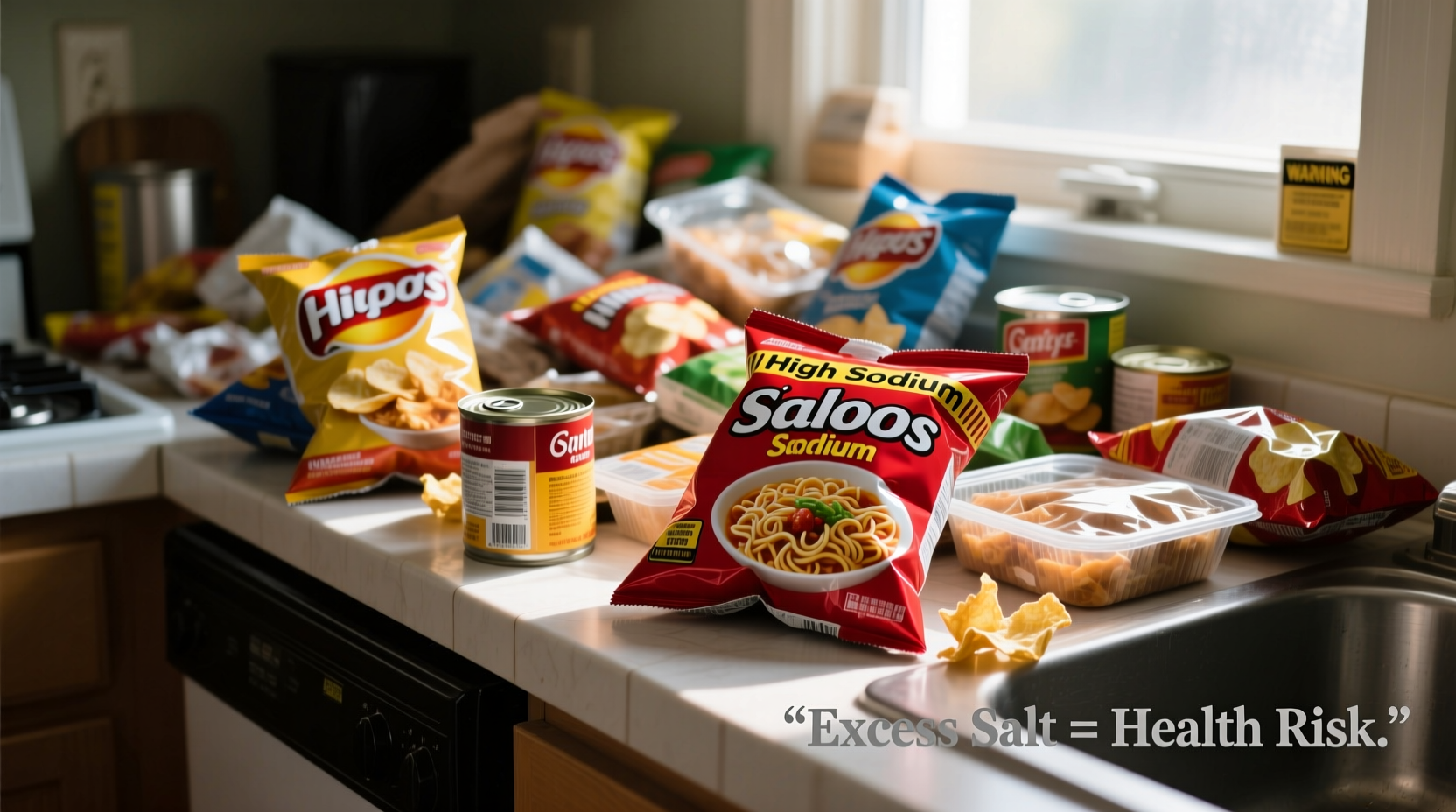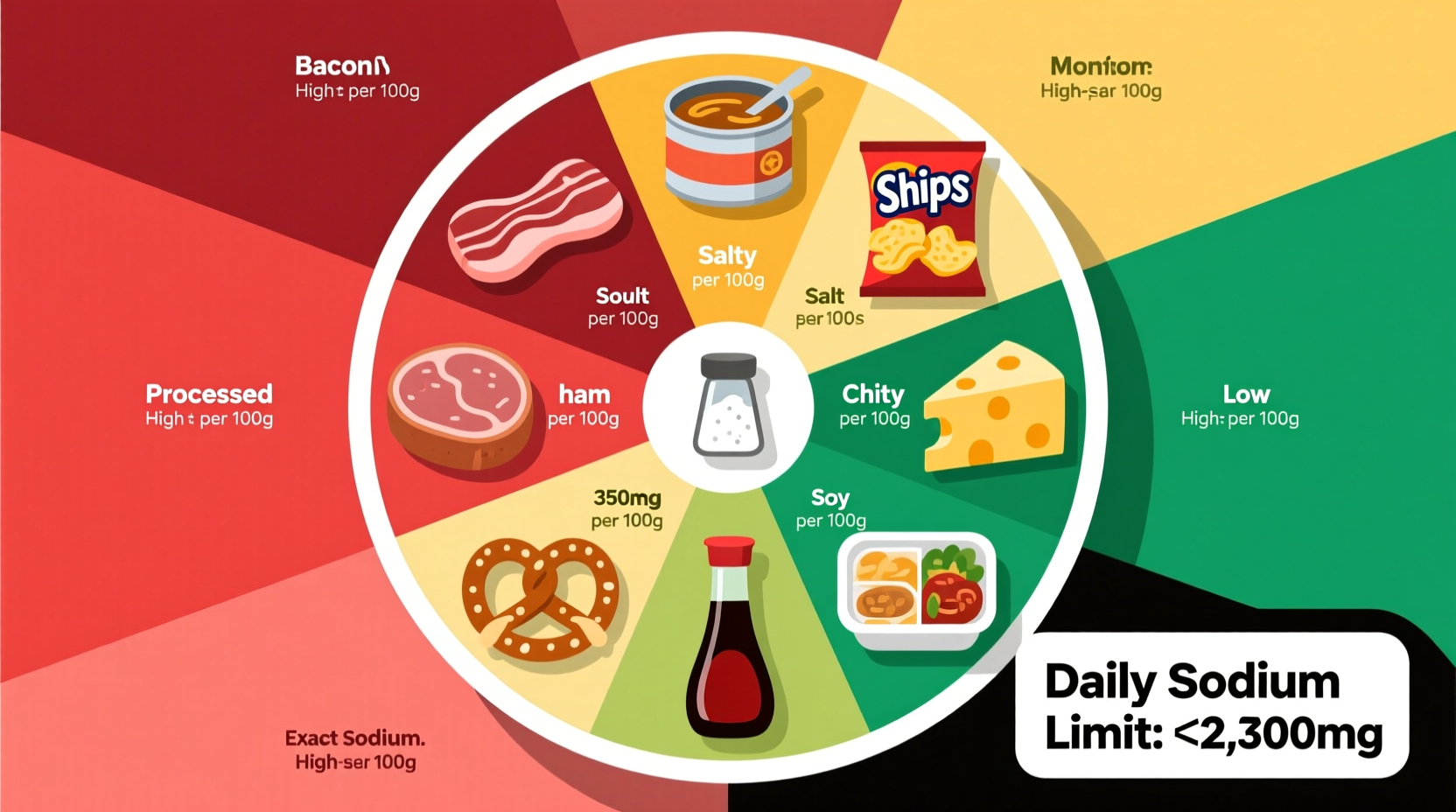Top high-salt foods include processed meats (bacon, ham), canned soups, pizza, sandwiches, and fast food burgers. Cutting these can reduce your daily sodium intake by 1,000+ mg, supporting heart health and blood pressure management.
Why Knowing High-Salt Foods Matters
Excess sodium intake affects 90% of adults globally, often without realizing it. The World Health Organization reports most people consume double the recommended 2,000 mg daily limit. Hidden salt lurks in everyday foods, making identification crucial for preventing hypertension and cardiovascular issues. This guide reveals exactly which foods pack dangerous sodium levels and how to navigate them.
Top 10 High-Salt Foods Revealed
Processed foods dominate the high-sodium landscape. Here's what nutrition data shows about common culprits:
| Food Item | Serving Size | Sodium (mg) | Source |
|---|---|---|---|
| Canned tomato soup | 1 cup | 800-1,200 | Nutritionix USDA |
| Pizza (cheese) | 1 slice | 640-800 | CDC Food Database |
| Processed deli meats | 2 oz | 450-700 | American Heart Association |
| Fast food burger | 1 patty | 900-1,200 | Nutritionix USDA |
| Soy sauce (regular) | 1 tbsp | 900-1,000 | USDA FoodData Central |
Note: Values vary significantly by brand and preparation method. Always check nutrition labels as "reduced-sodium" versions can cut sodium by 25-40%.
Why Processed Foods Hide Dangerous Salt Levels
Manufacturers add salt for three critical reasons: preservation, flavor enhancement, and texture control. Cured meats like bacon use salt to prevent bacterial growth during storage. Frozen meals rely on sodium to maintain consistent taste after reheating. Even seemingly healthy options like whole-grain bread average 150-200 mg per slice - a silent contributor when multiple slices are consumed.

Surprising Everyday Foods With Hidden Salt
Don't be fooled by bland tastes. These common items pack serious sodium:
- Bread and rolls: Contribute 7% of daily sodium intake despite mild flavor (CDC)
- Salad dressings: 1 serving often contains 200-400 mg
- Breakfast cereals: Some contain more sodium than sugar per serving
- Pasta sauces: Jarred varieties average 500 mg per ½ cup
Practical Steps to Reduce Sodium Intake
Implement these chef-tested strategies immediately:
- Decode labels: Look for "sodium," "soda," or "Na" in ingredients. Choose products with <140 mg per serving.
- Rinse canned goods: Draining and rinsing beans or vegetables cuts sodium by 40% (Journal of Food Science).
- Use acid instead of salt: Lemon juice or vinegar enhances flavor perception without sodium.
- Build flavor layers: Start with aromatics (onions, garlic) before adding minimal salt.
- Choose fresh alternatives: Opt for frozen vegetables without sauce over canned options.
Understanding Sodium Limits and Health Impact
The American Heart Association emphasizes that exceeding 2,300 mg daily increases cardiovascular risks. For context:
- 1 teaspoon salt = 2,300 mg sodium
- Average American intake = 3,400 mg daily
- Ideal limit for hypertension patients = 1,500 mg
Reducing intake by just 1,000 mg daily lowers systolic blood pressure by 5-6 mmHg in hypertensive individuals (New England Journal of Medicine).
Frequently Asked Questions
What is the recommended daily sodium limit?
The CDC and American Heart Association recommend no more than 2,300 mg per day for adults, with an ideal limit of 1,500 mg for those with hypertension. Most adults consume over 3,400 mg daily.
Which common breakfast foods are high in salt?
Cured meats (bacon, ham), bagels, and some cereals are major breakfast sodium sources. A single slice of bacon averages 190 mg, while a plain bagel contains 400-500 mg. Oatmeal and fresh fruit make lower-sodium alternatives.
How can I identify hidden salt in foods?
Check nutrition labels for sodium content per serving and scan ingredients for words like "soda," "sodium," or "Na." Be aware that bread, pasta sauces, and salad dressings often contain hidden salt. The CDC notes that 70% of dietary sodium comes from processed and restaurant foods.
Are there high-salt foods that don't taste salty?
Yes, bread and rolls are prime examples. They contribute significantly to daily sodium intake despite mild flavor. One slice typically contains 100-200 mg of sodium. Other surprising items include sweetened breakfast cereals and baked goods where salt enhances sweetness perception.
What are immediate benefits of reducing salt intake?
Within 3-5 days, reduced bloating and water retention are common. Blood pressure improvements can occur within weeks, especially for salt-sensitive individuals. Long-term, lowering sodium intake significantly decreases risks of stroke, heart disease, and kidney damage according to WHO research.











 浙公网安备
33010002000092号
浙公网安备
33010002000092号 浙B2-20120091-4
浙B2-20120091-4